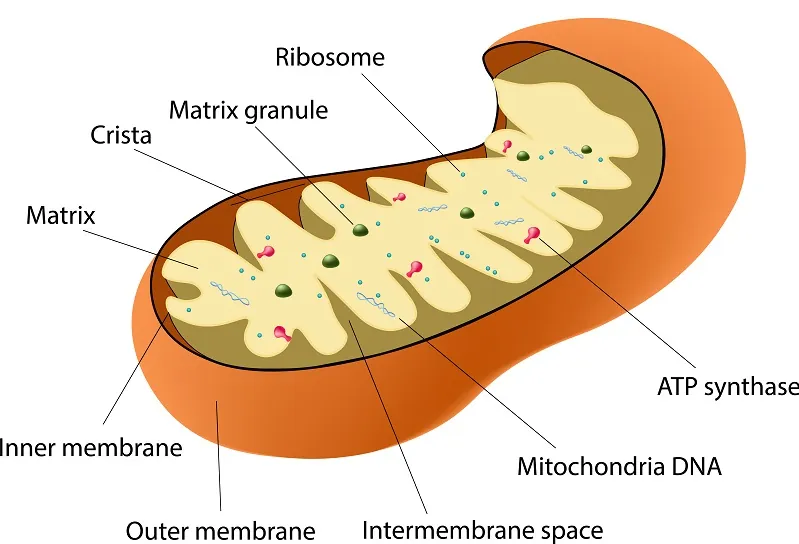Why We Age: Mitochondrial Dysfunction
Mitochondrial dysfunction is one of the root causes of aging as described in the Hallmarks of Aging [1]. As they age, mitochondria lose their ability to provide cellular energy and release reactive oxygen species that harm cells.
What are mitochondria?
Mitochondria, which are often called the powerhouses of cells, act like miniature factories, converting the food we eat into usable energy in the form of a chemical called adenosine triphosphate (ATP) [2]. ATP provides energy to fuel a myriad of cellular processes, such as muscle contraction, nerve impulse propagation, and protein synthesis. ATP is common to all forms of life and is often referred to as the “molecular unit of currency” of intracellular energy transfer.

Interestingly, mitochondria did not originate as part of multicellular life; they are stowaways in our cells and have their own unique DNA, which is separate from our own. It is widely thought that they merged with a very early ancestor of all multicellular life to form a symbiotic relationship [3]. Mitochondria become dysfunctional as we age and are host to their own separate (though similar) forms of damage.
How do mitochondria become dysfunctional?
As we age, our mitochondria go through changes that harm their ability to provide us with chemical energy while causing the release of harmful reactive oxygen species [4], which can cause DNA mutations leading to cancer [5-6] and even harm proteostasis [7]. Reactive oxygen species also drive muscle weakness [8], a further smoldering level of background inflammation (inflammaging) [9], and the associated bone frailty [10], senescent cell load [11] and immune suppression [12] of old age. Mitochondria from elderly people even look different [13]; they swell while their numbers dwindle, unable to replace themselves as quickly in their dysfunctional state [14-15].
These problems aren’t all that reactive oxygen species can cause, however; they can also cause mutations in mitochondrial DNA. [16] While some studies suggest that this damage is not done directly [17], it must be remembered that reactive oxygen species can damage the very proteins that would control the reproduction of mitochondria and introduce additional errors into the copies by extension [7].
While most of these issues are detected by quality-control mechanisms in the cell [18], causing damaged mitochondria to be destroyed through a process called mitophagy, these systems become less and less effective with age, decreasing in activity and eventually allowing errors to slip through. In some cases, this isn’t so bad; each cell contains a large number of mitochondria, so ten or even a few hundred being mutated isn’t a problem. However, some of these errors can make the dysfunctional mitochondria survive longer than healthy mitochondria. In this way, some types of dysfunctional mitochondria build up and eventually become more common than healthy ones [19].
Additionally, as aging progresses, NAD+ levels in human cells decrease, causing a breakdown in communication between the human nucleus and mitochondrial DNA, again leading to decreased energy production and increased reactive oxygen species production [20].
How could we prevent or reverse this?
A number of methods have been proposed for preventing this. First of all, the issues with NAD+ could be solved by some method of NAD+ supplementation, slowing down the accumulation of this damage. In addition, the most vital parts of the mitochondrial DNA could be moved to another part of the cell – the nucleus – giving it access to better DNA repair mechanisms and keeping it away from the source of reactive oxygen species [21]. This approach has been demonstrated for some of this vital code [22]. Of particular note, the study proving that this is possible was funded on our crowdfunding platform Lifespan.io!
Conclusion
Mitochondrial dysfunction is an important part of the aging process. These miniature chemical engines, while capable of self-replication, gradually become more dysfunctional with age through a variety of mechanisms, causing harm to our cells and encouraging more dysfunction in a vicious cycle. Quality control mechanisms hold this at bay for a time, but they eventually fail, leading to multiple diseases of aging and a long-lasting, chronic background level of inflammation called inflammaging.
Literature
[1] López-Otín, C., Blasco, M. A., Partridge, L., Serrano, M., & Kroemer, G. (2013). The hallmarks of aging. Cell, 153(6), 1194-1217.
[2] Lodish, H., Berk, A., Zipursky, S. L., Matsudaira, P., Baltimore, D., & Darnell, J. (2000). Electron Transport and Oxidative Phosphorylation.
[3] Gray, M. W., Burger, G., & Lang, B. F. (2001). The origin and early evolution of mitochondria. Genome biology, 2(6), reviews1018-1.
[4] Lesnefsky, E. J., & Hoppel, C. L. (2006). Oxidative phosphorylation and aging. Ageing research reviews, 5(4), 402-433.
[5] McAdam, E., Brem, R., & Karran, P. (2016). Oxidative Stress–Induced Protein Damage Inhibits DNA Repair and Determines Mutation Risk and Therapeutic Efficacy. Molecular Cancer Research.
[6] Suzuki, D. T., & Griffiths, A. J. (1976). An introduction to genetic analysis. WH Freeman and Company..
[7] Korovila, I., Hugo, M., Castro, J. P., Weber, D., Höhn, A., Grune, T., & Jung, T. (2017). Proteostasis, oxidative stress and aging. Redox biology, 13, 550-567.
[8] Alway, S. E., Mohamed, J. S., & Myers, M. J. (2017). Mitochondria Initiate and Regulate Sarcopenia. Exercise and sport sciences reviews, 45(2), 58-69.
[9] Rimessi, A., Previati, M., Nigro, F., Wieckowski, M. R., & Pinton, P. (2016). Mitochondrial reactive oxygen species and inflammation: molecular mechanisms, diseases and promising therapies. The international journal of biochemistry & cell biology, 81, 281-293.
[10] Lane, R. K., Hilsabeck, T., & Rea, S. L. (2015). The role of mitochondrial dysfunction in age-related diseases. Biochimica et Biophysica Acta (BBA)-Bioenergetics, 1847(11), 1387-1400.
[11] Kamogashira, T., Hayashi, K., Fujimoto, C., Iwasaki, S., & Yamasoba, T. (2017). Functionally and morphologically damaged mitochondria observed in auditory cells under senescence-inducing stress. NPJ aging and mechanisms of disease, 3(1), 2.
[12] Frasca, D., & Blomberg, B. B. (2016). Inflammaging decreases adaptive and innate immune responses in mice and humans. Biogerontology, 17(1), 7-19.
[13] Gerencser, A. A., Doczi, J., Töröcsik, B., Bossy-Wetzel, E., & Adam-Vizi, V. (2008). Mitochondrial swelling measurement in situ by optimized spatial filtering: astrocyte-neuron differences. Biophysical journal, 95(5), 2583-2598.
[14] Seo, A. Y., Joseph, A. M., Dutta, D., Hwang, J. C., Aris, J. P., & Leeuwenburgh, C. (2010). New insights into the role of mitochondria in aging: mitochondrial dynamics and more. J Cell Sci, 123(15), 2533-2542.
[15] Figge, M. T., Reichert, A. S., Meyer-Hermann, M., & Osiewacz, H. D. (2012). Deceleration of fusion–fission cycles improves mitochondrial quality control during aging. PLoS computational biology, 8(6), e1002576.
[16] Lee, H. C., & Wei, Y. H. (2007). Oxidative stress, mitochondrial DNA mutation, and apoptosis in aging. Experimental biology and medicine, 232(5), 592-606.
[17] Itsara, L. S., Kennedy, S. R., Fox, E. J., Yu, S., Hewitt, J. J., Sanchez-Contreras, M., … & Pallanck, L. J. (2014). Oxidative stress is not a major contributor to somatic mitochondrial DNA mutations. PLoS genetics, 10(2), e1003974.
[18] Srivastava, S. (2017). The mitochondrial basis of aging and age-related disorders. Genes, 8(12), 398.
[19] Luo, C., Li, Y., Wang, H., Feng, Z., Li, Y., Long, J., & Liu, J. (2013). Mitochondrial accumulation under oxidative stress is due to defects in autophagy. Journal of cellular biochemistry, 114(1), 212-219.
[20] Gomes, A. P., Price, N. L., Ling, A. J., Moslehi, J. J., Montgomery, M. K., Rajman, L., … & Mercken, E. M. (2013). Declining NAD+ induces a pseudohypoxic state disrupting nuclear-mitochondrial communication during aging. Cell, 155(7), 1624-1638.
[21] Boominathan, A., Vanhoozer, S., Basisty, N., Powers, K., Crampton, A. L., Wang, X., … & O’Connor, M. S. (2016). Stable nuclear expression of ATP8 and ATP6 genes rescues a mtDNA Complex V null mutant. Nucleic acids research, 44(19), 9342-9357.
[22] Boominathan, A., Vanhoozer, S., Basisty, N., Powers, K., Crampton, A. L., Wang, X., … & O’Connor, M. S. (2016). Stable nuclear expression of ATP8 and ATP6 genes rescues a mtDNA Complex V null mutant. Nucleic acids research, 44(19), 9342-9357.



